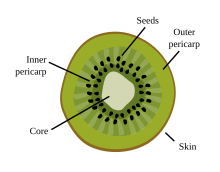**1. Kiwifruit Varieties and Cultivation:**
– The genus Actinidia comprises around 60 species.
– Commonly sold kiwifruit is derived from A.deliciosa (fuzzy kiwifruit).
– Other commonly eaten species include A.chinensis, A.coriacea, A.arguta, A.kolomikta, A.melanandra, A.polygama, and A.purpurea.
– Fuzzy kiwifruit cultivars include Hayward, Blake, and Saanichton 12.
– Kiwi berries are produced by species Actinidia arguta, A. kolomikta, and A. polygama.
– Actinidia chinensis (yellow kiwi) has a smooth, bronze skin and is sweeter than A.deliciosa.
– Kiwifruit can be grown in most temperate climates with adequate summer heat.
– Kiwifruit plants are generally dioecious, with male and female plants.
– Seeds produced are crossbreeds of their parents.
– Seedlings take seven years before reaching fruit-bearing maturity.
**2. Kiwifruit Cultivation Practices:**
– Commercial planting of Hayward began in the 1940s.
– Cross-species pollination can be successful if bloom times are synchronized.
– Native bumblebees and birds are natural pollinators of kiwifruit.
– Vigorous pruning is required for kiwifruit vines.
– Kiwifruit plants reach peak production at 8-10 years old.
– Proper storage methods can prolong the shelf life of ripe kiwifruit.
– PSA, a bacterial strain, has affected kiwifruit orchards in various regions.
– New, resistant kiwifruit varieties were developed to combat PSA.
– Kiwifruit exports from New Zealand increased rapidly in the late 1960s.
– Zespri is the brand name under which New Zealand kiwifruit is marketed.
**3. Kiwifruit Nutrition and Allergies:**
– Green kiwifruit is rich in vitamin C and vitamin K.
– Gold kiwifruit has higher vitamin C content.
– Kiwifruit is a low-calorie fruit with moderate vitamin E content.
– Allergy to kiwifruit was first described in 1981.
– Actinidain in kiwifruit can be an allergen, especially for children.
– Symptoms range from localized oral allergy syndrome to anaphylaxis.
– Common symptoms include mouth itching and soreness.
**4. Culinary Uses and Commercial Aspects:**
– Kiwifruit can be eaten raw, used in juices, baked goods, or as a garnish.
– Traditionally used in China for medicinal purposes.
– Kiwifruit production and trade between countries like New Zealand and China.
– Development of new kiwifruit varieties like Zespri Gold.
– Impact of pests like PSA on kiwifruit industry.
**5. Kiwifruit Research and Market Analysis:**
– Studies on kiwifruit allergens and clinical manifestations.
– Transformation of carotenoid biosynthetic genes in kiwifruit.
– Kiwifruit market analysis from an institutional perspective.
– Export market arrangements in the New Zealand kiwifruit industry.
– Kiwifruit allergy prevalence across Europe.
Kiwifruit (often shortened to kiwi outside New Zealand and Australia) or Chinese gooseberry is the edible berry of several species of woody vines in the genus Actinidia. The most common cultivar group of kiwifruit (Actinidia deliciosa 'Hayward') is oval, about the size of a large hen's egg: 5–8 centimetres (2–3 inches) in length and 4.5–5.5 cm (1+3⁄4–2+1⁄4 in) in diameter. It has a thin, fuzzy, fibrous, tart but edible light brown skin and light green or golden flesh with rows of tiny, black, edible seeds. The fruit has a soft texture with a sweet and unique flavour.

A = A. arguta, C = A. chinensis, D = A. deliciosa, E = A. eriantha, I = A. indochinensis, P = A. polygama, S = A. setosa.



Kiwifruit is native to central and eastern China. The first recorded description of the kiwifruit dates to the 12th century during the Song dynasty. In the early 20th century, cultivation of kiwifruit spread from China to New Zealand, where the first commercial plantings occurred. The fruit became popular with British and American servicemen stationed in New Zealand during World War II, and later became commonly exported, first to Great Britain and then to California in the 1960s.
